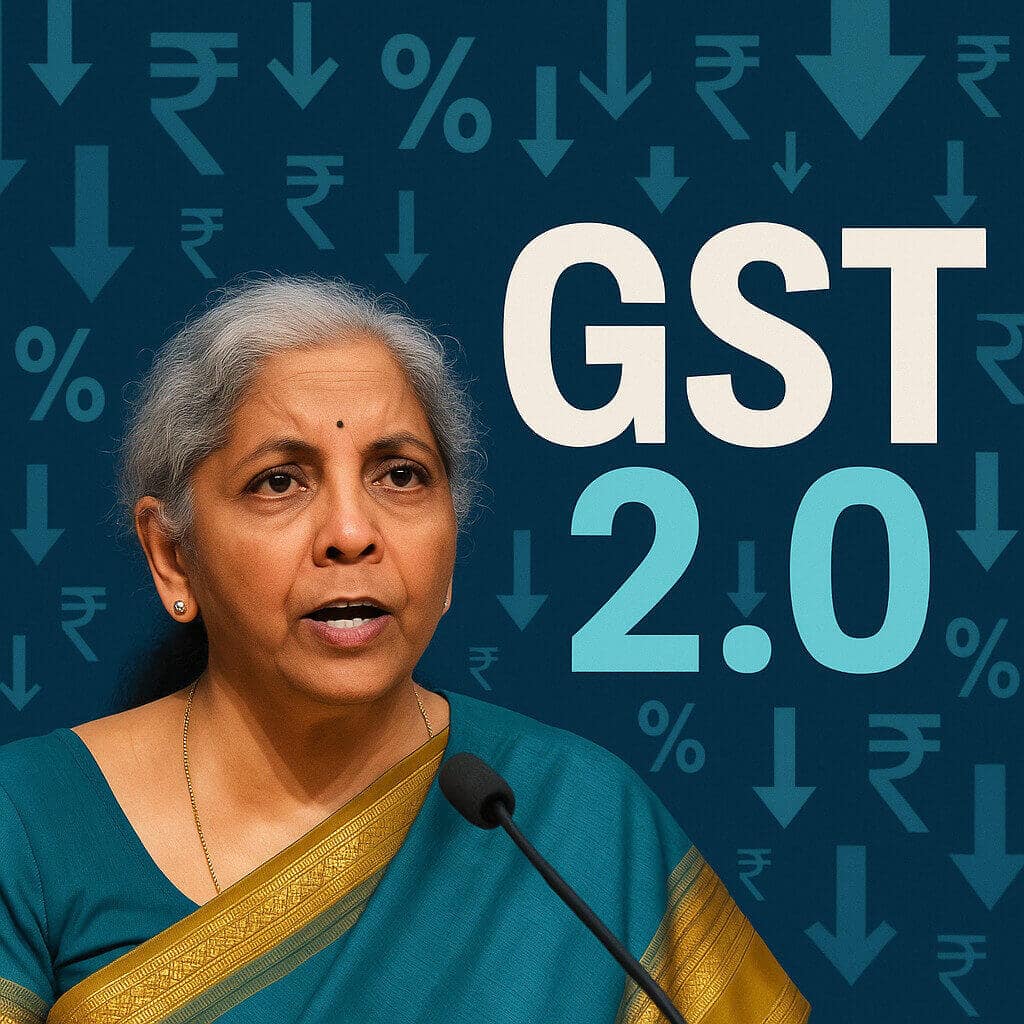
Featured image showing Finance Minister Nirmala Sitharaman's GST rate cuts announcement with tax reduction visuals
Finance Minister Nirmala Sitharaman has announced the most comprehensive GST overhaul since its inception, introducing sweeping GST rate cuts 2025 that promise to transform India’s taxation landscape. The landmark decision by the 56th GST Council meeting simplifies the complex four-tier structure into a consumer-friendly two-slab system, delivering substantial relief to millions of Indian households.
What Are the New GST Rates Under This Historic Reform?
The revolutionary GST rate cuts 2025 introduce a streamlined structure effective from September 22, 2025. The new framework eliminates the confusing 12% and 28% slabs, replacing them with a simplified system featuring:
- 5% Merit Rate: For essential goods and services used by common people
- 18% Standard Rate: For most goods and services
- 0% Nil Rate: For basic necessities like milk, paneer, and Indian breads
- 40% Demerit Rate: For luxury and sin goods
Explore the Latest GST Calculator 2025 👈
(New Rates effective from September 22, 2025)
This transformation affects over 400 items across various categories, making daily essentials significantly more affordable for the average Indian consumer.
Revolutionary Changes: What Gets Cheaper Under GST Rate Cuts 2025?

Essential Household Items Now at 5% GST
The GST rate cuts 2025 bring dramatic relief to household budgets by slashing taxes on everyday items from 18% to just 5%:
- Hair oil, shampoo, and toothpaste
- Toilet soaps and shaving cream
- Toothbrushes and personal care items
- Bicycles and kitchenware
- Tableware and household articles
Food Items Experience Major Tax Reduction
Food security receives a significant boost with these GST rate cuts 2025:
From 12% to 5%: Butter, ghee, cheese, namkeen, bhujia, instant noodles, chocolates, coffee, cornflakes, pasta, and sauces
From 5% to 0%: Ultra-high temperature milk, paneer, chena, and all Indian breads including roti, chapati, and paratha
Healthcare and Life-Saving Medicines
The GST rate cuts 2025 prioritize public health by exempting 33 life-saving drugs from taxation entirely. Additionally, all individual life and health insurance policies are now completely GST-free, making healthcare more accessible to common people.
Automotive and Electronics: Big Ticket Items Become Affordable
Vehicle Categories Under New GST Structure
The automotive sector witnesses substantial benefits from GST rate cuts 2025:
- Small cars and motorcycles up to 350cc: Reduced from 28% to 18%
- Buses, trucks, and ambulances: Cut to 18% from 28%
- Three-wheelers: Now at 18% instead of 28%
- Large cars and motorcycles above 350cc: Moved to 40% category
Consumer Electronics Get Major Relief
GST rate cuts 2025 make technology more accessible:
- All televisions: Reduced from 28% to 18%
- Air conditioning machines: Cut to 18% from 28%
- Dishwashing machines: Now at 18%
Agriculture and MSME Sector: Comprehensive Support
Farming Equipment and Agricultural Inputs
The GST rate cuts 2025 strongly support India’s agricultural backbone:
- All agricultural machinery: Reduced from 12% to 5%
- Sprinklers and drip irrigation systems: Cut to 5%
- Harvesters, mowers, and composting machines: Now at 5%
- Tractor parts and accessories: Reduced significantly
MSME and Manufacturing Benefits
Small businesses receive substantial support through these GST rate cuts 2025:
- Man-made fiber: Reduced from 18% to 5%
- Yarn manufacturing: Cut from 12% to 5%
- Renewable energy devices: Lowered to 5%
Economic Impact: Revenue Implications and Growth Projections
Revenue Loss and Fiscal Management
While the GST rate cuts 2025 will result in an estimated revenue loss of ₹85,000-93,000 crores annually, experts believe this will be offset by increased consumption and better tax compliance. The government expects the boost in economic activity to compensate for the reduced tax rates.
GDP Growth and Consumption Boost
Economic analysts project that these GST rate cuts 2025 could boost GDP growth by 100-120 basis points. The reforms are expected to stimulate consumption worth ₹5.5 lakh crores, generating additional revenue through increased economic activity.
Implementation Timeline and Compliance Guidelines
When Do These Changes Take Effect?
The GST rate cuts 2025 become effective from September 22, 2025, coinciding with the beginning of Navratri. However, tobacco products including cigarettes, gutka, and pan masala will continue at existing rates until compensation cess obligations are fully discharged.
Business Preparation Requirements
Companies must prepare for the GST rate cuts 2025 by:
- Updating ERP and accounting systems
- Revising MRP labels on consumer goods
- Adjusting contracts and pricing strategies
- Reconfiguring input tax credit calculations
What Items Become More Expensive?
Luxury and Sin Goods at 40% GST
The GST rate cuts 2025 introduce a new 40% slab for:
- Large cars exceeding specified dimensions
- Motorcycles above 350cc
- Yachts and private aircraft
- All aerated beverages and carbonated drinks
- High-end luxury items
Industry Response and Market Reaction
Corporate Sector Welcomes Reform
Industry leaders have praised the GST rate cuts 2025 as a game-changing reform. The Confederation of Indian Industry (CII) confirmed that businesses will pass on the benefits to consumers, ensuring the reforms achieve their intended impact.
Stock Market Impact
Markets responded positively to the GST rate cuts 2025 announcement, with FMCG, automotive, healthcare, and infrastructure stocks rallying significantly. Companies in affected sectors are expected to see improved profit margins and increased demand.
People Also Ask (PAA) Section
Q: When will the new GST rates come into effect?
A: The GST rate cuts 2025 will be implemented from September 22, 2025, except for tobacco products which will transition later.
Q: How much will consumers save from these GST rate cuts?
A: Households can expect savings of 10-15% on essential items, with grocery bills potentially reducing by nearly 15%.
Q: Which items are completely exempt from GST now?
A: Life and health insurance policies, 33 life-saving medicines, UHT milk, paneer, and Indian breads are now GST-free.
Q: Will petrol and diesel prices be affected?
A: Petrol and diesel remain outside the GST framework and are not affected by these GST rate cuts 2025.
Q: How will these changes affect small businesses?
A: MSMEs benefit through reduced input costs, faster registration (3 days instead of 30), and automated refund processes.
Conclusion: A New Era of Simplified Taxation
The GST rate cuts 2025 represent more than mere tax adjustments—they constitute a fundamental shift toward a more equitable and growth-oriented taxation system. By prioritizing essential goods, healthcare, education, and agriculture, Finance Minister Nirmala Sitharaman has delivered on the promise of making GST a true catalyst for economic growth.
These reforms will boost consumer confidence, support small businesses, and strengthen India’s manufacturing competitiveness. As we approach the September 22 implementation date, businesses and consumers alike can look forward to a simplified, more affordable tax regime that puts the common man first.
Ready to understand how these changes affect your business or household budget? Stay informed about the latest GST updates and ensure you’re prepared for the September 22 transition.
Read this also: https://trendingnowindia.in/apple-iphone-17-pro-max-launch-date-2025/






1 thought on “5 Major GST Rate Cuts 2025: How Finance Minister Nirmala Sitharaman’s Historic Reform Benefits Common Man”